Illuminating Dark Energy with Supernovae
By D. Andrew Howell
Catastrophic explosions in space reveal surprising information about the early universe.
Catastrophic explosions in space reveal surprising information about the early universe.

DOI: 10.1511/2013.103.274
A supernova is a powerful explosion that occurs when a star is transformed by nuclear fusion or gravitational collapse. Supernovae emit bright light and release large amounts of energy. Astronomers study the properties of light and energy from supernovae to determine how quickly each one is moving away from Earth, which can be used to extrapolate the history of the expansion of the universe. Such studies of supernovae led to the discovery of dark energy in the late 1990s. Traditional modes of allocating time on the most powerful telescopes in the world limit study of supernovae. Astronomers studying them do not need a large block of time each year but rather need many small blocks of time, because supernovae only last a few weeks. D. Andrew Howell proposes a solution that incorporates robotics into telescope technology—if today’s leading astronomers could find the funding to make this change, the secrets of the early universe would be revealed.
I’m in a large lot east of Los Angeles, squatting with a detonator in my hand. It is wired up to a 6-foot-diameter bomb—a weather balloon filled with acetylene and oxygen. Welders’ torches use tiny amounts of these gases. I can’t imagine what exploding 100 cubic feet will do.
Steve “Jake” Jacobs, the man behind many of the demos on the Discovery Channel’s MythBusters series, says, “I’ve seen this kind of explosion before. I’m going to be standing about 40 feet back that way. It was nice knowing you, Andy.”
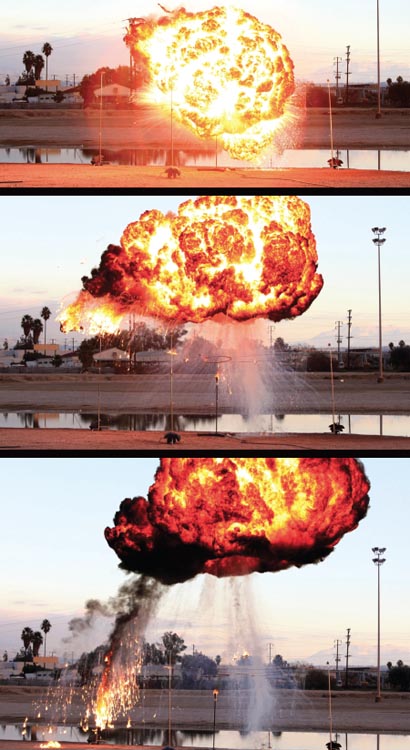
Images by Kat Marcinowski, courtesy of Base Productions.
“Wait!” I say. “Is this safe?” A cameraman and I have to be much closer than I’d like to be. The rest of the crew is dozens of yards away or hiding behind cars. I try to reassure myself that our special effects expert just finished working on Transformers 3, directed by action movie hack Michael Bay. Surely, Bay’s explosion guy is the best in the world. At least he has the most practice.
Cameras roll. I arm the switch. Someone shouts, “Fire in the hole!” I say, “I get to light my own supernova!” push the detonator, and …
A shock wave hits me like a wall, almost knocking me off my feet. I stumble backward to catch my footing. The cameraman is a professional and knows he’s supposed to be silent, yet he is so stunned he shouts, “Oh my God!” Someone else on the set shouts, “Holy Mother!” and comes running over. But the point of this shot is to catch my reaction, so the producer is waving his hands trying to quiet everyone else down. I’m still in mid-freak-out, unleashing a string of expletives. We scramble to catch the rising smoke ring on camera—a product of our own little mushroom cloud—as I try to switch from primal monkey to composed astrophysicist to explain it.
Soon the phones start ringing—people on another shoot more than mile away want to know if we’re okay. We radio the guys in a crane we’ve set up to film the explosion from another angle to ask if the high-speed footage came out. They respond that it was too powerful: The camera was saturated, and they just have white frames. We’re going to have to do it again, and we’re losing the light.
We’ve got one more shot at it. Another balloon is filled. The mixture is tweaked, and the camera is stopped down. When I hit the detonator again, the result is a gorgeous fireball—a work of explosive art.
When the episode went to air, the beautiful explosion was paired with my expletive-laden, stumbling reaction to the first, more powerful one. This isn’t science, it’s show business.
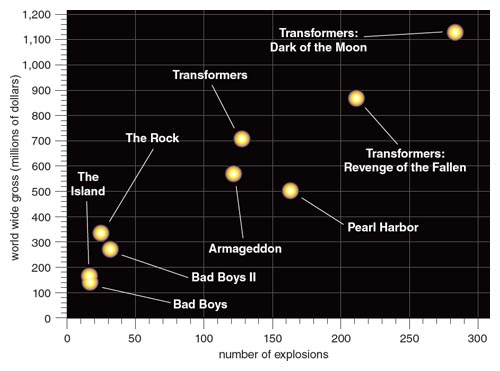
Illustration by Tom Dunne
This stunt was for a show called Known Universe on the National Geographic Channel. Like Michael Bay, television producers know that more explosions lead to higher ratings (Figure 2). But the ostensible reason was to dramatize supernovae, stellar explosions so distant that we never resolve the expanding fireball. Our parking lot shenanigans have painted a picture of a supernova in the viewers’ heads. And yet it is wildly, completely wrong.
The explosion we filmed released about 100 million joules of energy. But a kind of supernova called a Type Ia supernova explodes with energy of 1044 joules—an obscene factor of 1036 more powerful (see the sidebar for more about the different types of supernovae). Explosions this powerful are incomprehensible to us on a basic level, because we seldom experience the ratio of any two quantities this extreme on Earth, where our brains evolved. Perhaps no performance in the history of cinema or television has failed to dramatize its subject by a greater margin. A supernova would easily eradicate any life unfortunate enough to be in the vicinity. They shine as bright as 6 billion Suns at once, and can be seen across nearly the entire observable universe.
There are other differences, too: the terrestrial explosion was powered by rearranging the chemical bonds in acetylene (C2H2) and oxygen (O2). But the burning in a Type Ia supernova explosion isn’t chemical, it is thermonuclear fusion.
Video courtesy of Base Productions.
Before it becomes a Type Ia supernova, a white dwarf star is an Earth-sized sphere of carbon and oxygen. In a split second, it becomes a hellish fireball of radioactivity and newly cooked elements, flying apart at a tenth the speed of light. In the time it takes you to sneeze, a shock wave rips through the 8,000-mile-wide star, fusing the carbon and oxygen into heavier and heavier elements, climbing the periodic table to nickel. Hapless medieval alchemists struggled for centuries to turn one element into another; they just didn’t have hot enough ovens. Above their heads, stars such as the Sun were converting hydrogen to helium, and helium to carbon. And every second, somewhere in the universe, a supernova was exploding and synthesizing in a flash most of the basic ingredients for humans. Although many of these elements are also created in stars, most of the iron in your blood was created in supernovae. Carl Sagan once said, “We are star stuff.” That’s true, but only part of the story: We are also supernova stuff.

Illustration by Tom Dunne
In a Type Ia supernova, massive amounts of radioactive nickel, 56Ni, are synthesized, nearly as much as the mass of the Sun. If you could convert it into actual nickels, one supernova would be worth $6 nonillion, meaning $6 x 1030. But this cosmic jackpot is fleeting; in a week most of the nickel decays into cobalt, specifically 56Co. Within a few months, most of the cobalt turns into iron (56Fe).
For astronomers, the real windfall is photons. Every radioactive decay, from 56Ni to 56Co to 56Fe, produces a gamma ray photon, the most energetic type of radiation. But the supernova is initially so dense that the gamma rays are trapped. Instead of leaving, they dance around inside the rapidly expanding star and are converted to light we can see. When each photon finally breaks free of its plasma prison, a few days or weeks after it was created, its journey has barely begun. It may travel intergalactic space for millions or billions of years before being absorbed by an eyeball or a digital camera. Each photon carries exactly one secret, one bit of information: its wavelength, which determines its color and energy.
Fortunately, a supernova emits 1055 of these photons, in an ever-expanding sphere that, over time, alerts any beings within the observable universe that there was a catastrophe. Even after this mind-bending geometrical dilution, many billions of photons still reach Earth. By a process of separately studying and averaging all that we can capture in a telescope, we can probe thousands of secrets about the inner workings of a supernova. By repeating this process for many supernovae, we can even deduce the entire expansion history of the cosmos and the dark energy underpinning it.
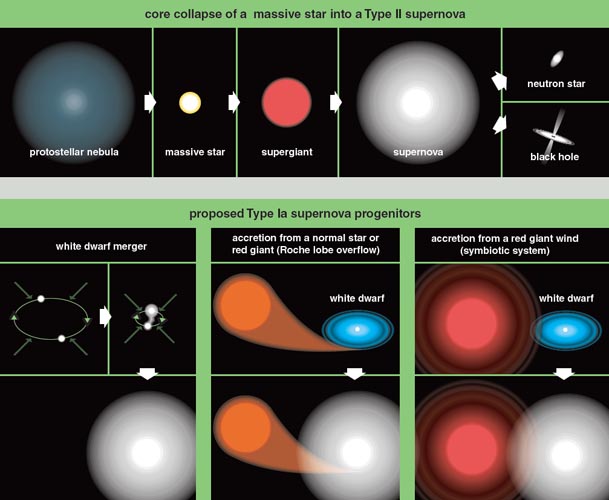
Illustration by Tom Dunne
This double magic act is possible because atoms and the expansion of the universe influence photons in two different ways. Elements within a supernova (and in any gas along the line of sight to it) absorb photons of certain wavelengths. Each one has a characteristic signature. When the light from a supernova is split into a rainbow, it superficially looks much like our familiar solar rainbows, but brighter in the bluer colors. In a supernova rainbow, there are dark bands where certain color photons have been absorbed. These dark bands actually exist in a solar rainbow, but are so narrow it takes a telescope to see them. They are much wider in a supernova thanks to the high velocity of the material. Astrophysicists read this like a bar code to determine the elements present in each layer of the supernova. From the atomic signature of the supernova, we can determine its type (To see sidebar click the image above).
But even after the photons have escaped, they do not survive their journey through the universe unmolested. In the millions or billions of years that they have been traveling toward Earth, the universe has been expanding. This expansion stretches the photons to longer wavelengths, making them redder. The farther away a supernova is, the more its photons are redshifted. For some of the most distant supernovae we’ve studied, our blue supernova rainbow is shifted so far toward red wavelengths that it becomes invisible to our eyes, emitting most of the light in the infrared. The redshift of these photons tells us how fast the supernovae and their host galaxies seem to be speeding away from the Milky Way due to the expansion of the universe. When paired with the distances, it allows us to make a map of how the universe’s expansion has been changing.
Albert Einstein was right about a great many things, but there was one thing he always regretted. In his cosmological equations, he reasoned that there must be a counteracting force to gravity. Otherwise, gravity would pull everything in the universe together. So he added a term, which he called the cosmological constant, to balance the effects of gravity. But in 1929, Edwin Hubble determined that the universe was expanding. Although planets, stars and galaxies are bound together by gravity, the galaxies themselves are flying away from one another. Realizing that in an expanding universe, there is no need to balance gravity Einstein was alleged to have called the cosmological constant his “biggest blunder.” Moreover, he was disappointed that he could have predicted the expanding universe as a solution to his equations, if only he’d been a bit more creative.
But the universe couldn’t have been expanding forever, nor could it always have been expanding at the same rate. If you run the expansion of the universe backward in time, you find that an extremely dense state occurred in the early stages, which we now refer to as the Big Bang. Measuring the expansion history of the universe could reveal how the expansion has been changing over time, which effectively “weighs” the universe. This knowledge would reveal the age of the universe, too.
To measure the history of the expansion of the universe, we need to know how fast the universe is expanding today compared to, say, 5 billion years ago or 10 billion years ago. Since the speed of light is finite, looking back in time is equivalent to looking farther away in distance. We need to make a map—not one of x versus y in position, but one where position (distance from Earth) is only one axis, and the other is the rate of expansion of the universe. As it turns out, measuring the rate of expansion is easy—that’s just the redshift of photons we have received from supernovae. The spectrum of a supernova reveals how fast it appears to be moving away from Earth, by how much all the photons have been stretched to longer wavelengths. This effect is similar to the Doppler shift, where sound waves from, for example, a receding siren, get stretched to a lower pitch. But we also need the distance to each supernova from Earth, and measuring that is not so simple.
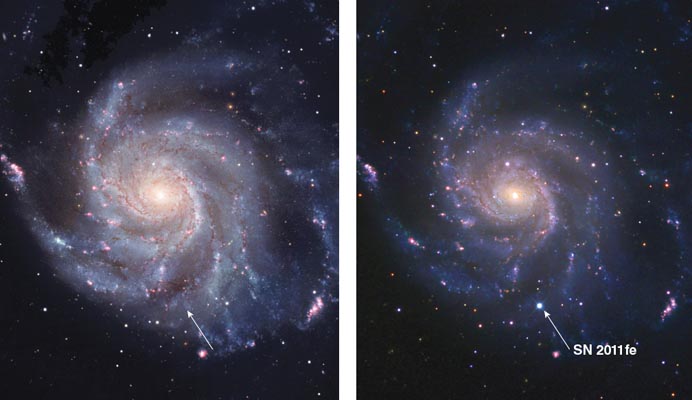
Image courtesy of B. J. Fulton of University of Hawaii, LCOGT, Space Telescope Science Institute, Palomar Transient Factory.
Fortunately, we can use a technique to determine the distances to Type Ia supernovae: We can treat them like standard candles. Although the term may have been invented before electricity, a better analogy is standard lightbulbs. If you filled the universe with 100-watt lightbulbs, you could easily determine the distances to them. Just compare the brightness you see to their intrinsic brightness. The physics is simple: because photons travel out of the lightbulb in all directions, the photons expand as a sphere. The surface area of a sphere is 4πr2, where r is the radius of the sphere, or your distance to the lightbulb. If you double your distance from a lightbulb, you’ll see the light dim by a factor of four.
In fact, if we really want to be clever, we don’t even need to know the wattage of the lightbulbs. If they are all the same, we can just compare their apparent brightness to determine the ratio of the distances. For example, we could determine that one supernova is twice as far as another by their appearance. But that gets tricky, because supernovae aren’t all the same intrinsic brightness. In other words, they aren’t all 100-watt lightbulbs; some are effectively 90 watts, and others are 110 watts. Fortunately, we can correct for these differences. Supernovae rise to peak brightness over the course of about 18 days, and this peak brightness is what we need to measure. But it turns out that the brighter supernovae, the 110-watt bulbs, take longer to reach peak brightness—about three weeks. The dimmer supernovae reach their maximum in only about two weeks. On top of that, the brighter supernovae are bluer, and the dimmer supernovae are redder. If you measure the color and rise- and fall-time of the supernova, you can correct for the fact that they aren’t exactly standard candles. They’re really “calibratable candles.“
In the late 1990s, two teams—the High-z Supernova Search Team (z is the abbreviation used for redshift) and the Supernova Cosmology Project (SCP)—used these methods to determine distances to far-away supernovae for comparison with nearby supernovae discovered by a Chilean group, the Calán/Tololo Supernova Search. They had expected to find that the universe was decelerating over time; that is, the expansion rate would be slowing down because of the mutual attraction of all the gravity of all the galaxies in the universe. But what they found instead was one of the most shocking and worldview-changing results in all of history: the universe’s expansion wasn’t slowing down. It was speeding up. This result would take some kind of energy, and because we can’t see it, it has been called dark energy, as a parallel to dark matter (the amount of mass in the universe that we also can’t see). The two are almost certainly unrelated, except in our relative ignorance of them compared to their terrestrial cousins. In 2011, the leaders of the High-z team, Brian Schmidt (now at the Australian National University) and Adam Riess (now at Johns Hopkins University), along with Saul Perlmutter of Lawrence Berkeley National Laboratory, who was the head of the SCP, were awarded the Nobel Prize in Physics for the discovery.
After the SCP and the High-z team discovered dark energy, the next step was to measure its properties in the hopes of learning what it is. Although the discovery was made using tens of supernovae, figuring out what it really is would require hundreds more and an entirely new approach. Astronomers from Canada and France decided to build what became the world’s largest digital camera, a 340-megapixel instrument that could image an unprecedented square degree—an area of the sky the size of four full moons at once. It was attached to the 3.6-meter Canada-France-Hawaii Telescope (CFHT) on Mauna Kea, and an unheard-of 10 percent of the time was dedicated to measuring the properties of dark energy. In 2003, the Supernova Legacy Survey (SNLS) began in earnest, backed by a global coalition of astronomers, including me, using not just the CFHT but most of the world’s largest telescopes.
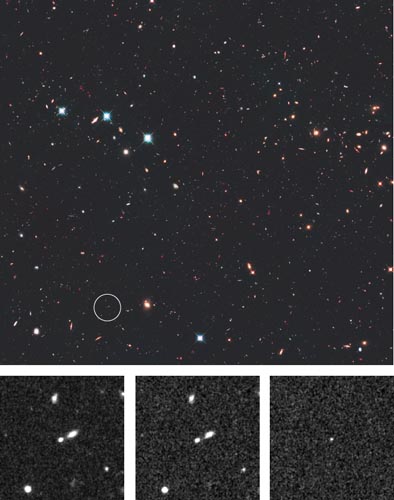
Images courtesy of NASA, ESA, A.Riess (STScl and JHU), and D. Jones and S. Rodney (JHU)
In previous supernova searches, groups would search for supernovae over large areas of the sky, using specialized wide-field cameras, then obtain follow-up observations of those supernovae over the course of two months, often with different cameras. But Megacam made possible a new approach called a rolling search. Two fields would be monitored at any given time, and images would be taken once every few days. Because the large telescope and large camera could look so deep into space, and over such a wide area, it would see about 40 supernovae at once. The search fields and follow-up observations would be one and the same: When new data were obtained, observers would search the images for new supernovae, while simultaneously following previously discovered ones.
The result was an order of magnitude increase in the discovery rate of distant supernovae, and much more precise information on each one. Because all data were from the same telescope, the observations could be calibrated more precisely. From 2003 to the end of the survey, in 2008, the SNLS obtained multicolor lightcurves of thousands of astronomical events. However, not all of them were supernovae.
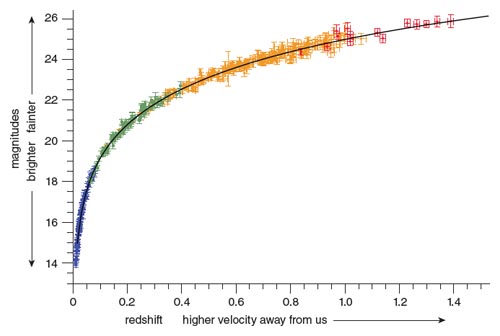
Image from A. Conley, et al. Astrophysical Journal doi:10.1088/0067-0049/192/1/1.
A spectrum is needed to tell whether a potential discovery is actually a supernova. For such distant supernovae, creating this spectrum requires big telescopes that can split the faint light finely enough. Most of the largest telescopes in the world, those with 8 meter or larger mirrors, have to be used to observe many distant supernovae. The project was so ambitious that a few percent of the time available on each telescope was designated each year to this project. Time on a large telescope is so precious that astronomers had to band together from many countries, using many telescopes, to obtain enough time to make the measurements. In the end, the SNLS spectroscopically confirmed about 450 Type Ia supernovae.
When we finally made our best map of the history of the expansion of the universe, the results were bizarre and counterintuitive, but not entirely unexpected. They indicated that the dark energy per unit volume in the universe is constant. This is odd: As the universe doubled in size, the amount of dark energy doubled. Unlike anything we are used to on Earth, as the universe expands, matter gets diluted but dark energy doesn’t. Strangely, this means that dark energy must be a property of space-time itself. Space has a natural springiness, a kind of natural antigravity that causes it to push itself apart. Scientists had seen this before: It was Einstein’s cosmological constant. The very term he called his “biggest blunder” was in fact a remarkable feat of prescience.
After the end of the SNLS, we were left with a dilemma. Ironically, distant supernovae were studied much better than nearby ones, because a very large area of the sky must be searched to find nearby supernovae. The rolling search trick won’t work: Specialized large-format cameras are still needed for searching with separate telescopes used for follow-up. But traditional astronomy is biased against studying rapidly varying phenomena. Time is usually allocated in individual nights, a handful per year, and the astronomer has to trek across the globe to make the observations. In most cases, it is economically and logistically prohibitive to take observations of nearby supernovae every few days.
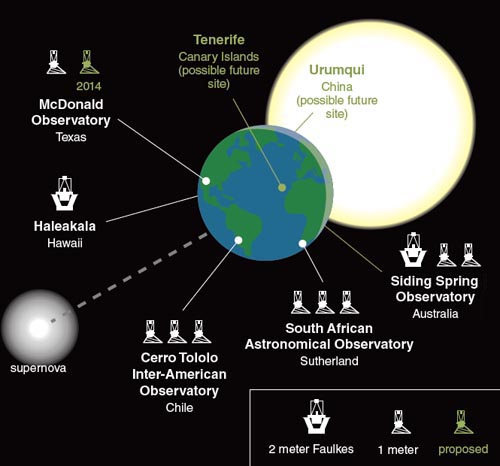
Telescope graphics courtesy of Stewart Lowe.
Queue scheduling of telescopes was a major innovation that ushered in the current supernova golden age. Rather than allocate whole nights to a given astronomer, a number of hours over a semester are allocated. Then, a dedicated astronomer at the telescope observes all targets in the queue for a given night, which can be from many different projects. So you could obtain 15 minutes of time per night to monitor a supernova, and without the added expense of traveling to the site. Still, queue observing comes with its own problems: The queue observer may not be an expert on taking the type of data required, and it is expensive, because several dedicated astronomers have to be hired per telescope.
The next innovation, a revolution that astronomers and engineers are in the early stages of developing, is robotic telescopes. The observing can be more efficient, because robots don’t get tired, and they can analyze images, monitor conditions and find targets faster than humans. They are also cheaper than hiring astronomers on-site, making new projects involving arrays of smaller telescopes feasible for the first time. One such project is the Las Cumbres Observatory Global Telescope Network (LCOGT), where I am a staff scientist. We are building a worldwide network of 0.4-meter, 1-meter and 2-meter telescopes, linked to make a single worldwide observatory. The ultimate network will consist of two 2-meter telescopes, 10 to 15 1-meter telescopes, and 16 to 24 40-centimeter telescopes, spread around the world at different sites. It will always be dark somewhere. For the first time, using LCOGT astronomers will be able to make continuous observations for days on end, without being interrupted by the rising sun. Any time a transient observation is needed, we’ll no longer have to wait for darkness to observe it.
An always-on, global robotic array of telescopes is perfect for the nearby supernova problem. Not only will it allow more observations than ever before, but rapid observations that are now all but impossible will become routine. Data taken soon after a supernova explosion can reveal details about the progenitor star, because remnants of the progenitor can still be seen in the outer layers of the supernova, before it has expanded and diluted them. And if you can catch a supernova while the shock is still breaking out of the surface of the star, or soon after, it can reveal the type of star that exploded.
The next leap in supernova cosmology requires putting a dedicated satellite in space. This concept was the top recommendation from the 2010 Astronomy and Astrophysics Decadal Survey, a panel of astronomers assembled to determine future directions in the field. The envisioned design is a satellite called WFIRST, for Wide-Field Infrared Survey Telescope, and it would be the first wide-field infrared telescope in space. It could find thousands of supernovae, much more distant and further back in time than we have ever seen them.
But there’s one big problem: The funding situation in astronomy is so dire, there isn’t money to do this top-priority research. Many astronomers had written it off. However, the idea may be resurrected with some scraps from the table of the better-heeled espionage community. In 2011, the U.S. National Reconnaissance Office (NRO) asked NASA whether it would have any use for two of its spare spy satellites. NASA assembled a classified team to look over the idea and found that it could have merit. For its part, the NRO decided that it could declassify some of its hardware. They gave NASA parts of two telescopes: the outer barrel assemblies, the 2.4-meter mirrors and the equipment for radiating heat. The movable secondary mirrors and cameras were too classified to give away, so NASA would have to build them on their own. The telescopes would have a quarter-square–degree field of view, about the size of the full moon, and a hundred times the area of the Hubble Space Telescope’s Wide Field Camera 3.
Although the NRO is being tight-lipped about the origin of the hardware, many have speculated that they are from the KH-11, or “Stubby Hubble,” series, which debuted in 1976. These were the first U.S. electro-optical imaging spy satellites, and were so nicknamed because they look a lot like the Hubble Space Telescope, even down to the same-sized primary mirror, but with a shorter focal length and thus a wider field of view. However, other sources indicate that they are in fact from a failed program called Future Imaging Architecture, after Boeing had massive budget overruns and was forced out of the contract.
Whatever their origin, it isn’t obvious that the spy satellites will save WFIRST. The astronomy mission is estimated to cost about $1.6 billion. Repurposing a spy satellite will save some money, but probably only about $250 million. NASA would still have to redesign WFIRST to use the new hardware, and then come up with a lot of cash for the parts they are missing. Still, one hopes that Congress could take the initiative to provide the missing funds, a fraction of what is undoubtedly spent on reconnaissance. I’d like to think Americans live in a country so awesome as to make possible the repurposing of telescopes from spying on people to spying on the secrets carried inside distant supernovae from the early universe.
Click "American Scientist" to access home page
American Scientist Comments and Discussion
To discuss our articles or comment on them, please share them and tag American Scientist on social media platforms. Here are links to our profiles on Twitter, Facebook, and LinkedIn.
If we re-share your post, we will moderate comments/discussion following our comments policy.